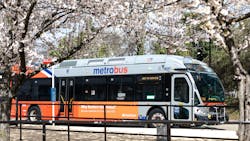WMATA ridership projections trending ahead of forecast
Ridership on the Washington Metropolitan Area Transit Authority (WMATA) is outpacing projections through the first three quarters of Fiscal Year 2022 by nearly 40 percent.
Through March, ridership has exceeded the initial forecast by 28 million passenger trips as more people chose bus and rail for travel throughout the region. Metrobus leads the way, accounting for 60 percent of overall WMATA ridership, compared to about 40 percent for rail.
People returning to offices, higher gas prices, the return of large-scale events and robust tourism are driving the resurgence. Ridership more than doubled as of March. Parking usage has tripled over the same period.
“These numbers are encouraging and welcome news for our regional mobility and economy,” said WMATA Board Chair Paul C. Smedberg. “While the board’s budget assumed conservative ridership forecasts in the interest of fiscal responsibility, we are delighted that people are returning to the system more often than expected.”
Following a slowdown in ridership recovery during the emergence of COVID-19 variants, WMATA ridership rebounded in March, boosted by businesses resuming in-person work, as well as visitors attending activities and events during cherry blossom season. Average weekday rail ridership peaked Tuesday through Thursday at 230,000 and bus at 280,000.
Ridership continued to trend up in April, reaching as high as 300,000 on Metrobus. During peak times the number of riders continued to climb, showing an uptick in SmartBenefits® usage. SmartBenefits users nearly tripled since January with a pandemic high of 66,000 riders.
“People returning to Metro reduces traffic, combats climate change, and delivers clients, customers and employees to federal workplaces and local businesses,” said WMATA General Manager and CEO Paul J. Wiedefeld. “As the region transitions out of the pandemic and our services continue to improve this summer, we expect more residents and visitors will choose Metro.”
The trend is positive news for WMATA’s bottom line, improving the financial outlook for the fiscal year ending June 30. More riders also mean more revenue from advertisers looking to capitalize on WMATA’s increasing customer base. Advertising revenue sold in the system has more than doubled and is $2 million ahead of last year’s budget. Revenue from advertising supports WMATA operations.
While ridership is expected to remain below pre-COVID numbers as the region’s travel behaviors change, Metrobus has reached 61 percent of pre-pandemic ridership levels. The positive trends for bus and rail are expected to continue, as the board-approved budget continues more frequent bus service through the next fiscal year and rail frequency improvements are anticipated in late summer with the restoration of the 7000-series railcars to the fleet.
